2013 NISSAN GT-R weight
[x] Cancel search: weightPage 25 of 346
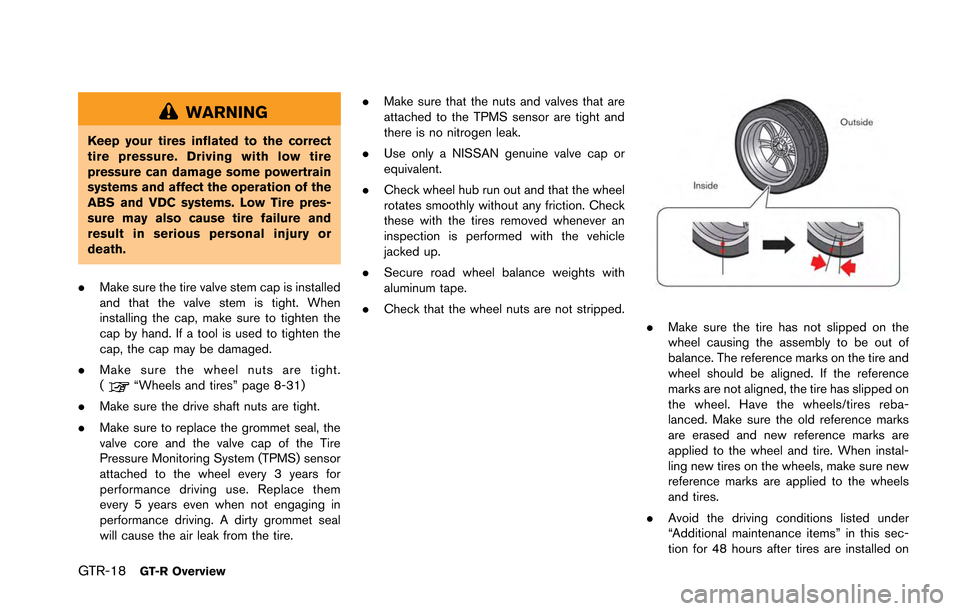
GTR-18GT-R Overview
WARNING
Keep your tires inflated to the correct
tire pressure. Driving with low tire
pressure can damage some powertrain
systems and affect the operation of the
ABS and VDC systems. Low Tire pres-
sure may also cause tire failure and
result in serious personal injury or
death.
. Make sure the tire valve stem cap is installed
and that the valve stem is tight. When
installing the cap, make sure to tighten the
cap by hand. If a tool is used to tighten the
cap, the cap may be damaged.
. Make sure the wheel nuts are tight.
(
“Wheels and tires” page 8-31)
. Make sure the drive shaft nuts are tight.
. Make sure to replace the grommet seal, the
valve core and the valve cap of the Tire
Pressure Monitoring System (TPMS) sensor
attached to the wheel every 3 years for
performance driving use. Replace them
every 5 years even when not engaging in
performance driving. A dirty grommet seal
will cause the air leak from the tire. .
Make sure that the nuts and valves that are
attached to the TPMS sensor are tight and
there is no nitrogen leak.
. Use only a NISSAN genuine valve cap or
equivalent.
. Check wheel hub run out and that the wheel
rotates smoothly without any friction. Check
these with the tires removed whenever an
inspection is performed with the vehicle
jacked up.
. Secure road wheel balance weights with
aluminum tape.
. Check that the wheel nuts are not stripped.
.Make sure the tire has not slipped on the
wheel causing the assembly to be out of
balance. The reference marks on the tire and
wheel should be aligned. If the reference
marks are not aligned, the tire has slipped on
the wheel. Have the wheels/tires reba-
lanced. Make sure the old reference marks
are erased and new reference marks are
applied to the wheel and tire. When instal-
ling new tires on the wheels, make sure new
reference marks are applied to the wheels
and tires.
. Avoid the driving conditions listed under
“Additional maintenance items” in this sec-
tion for 48 hours after tires are installed on
Page 62 of 346
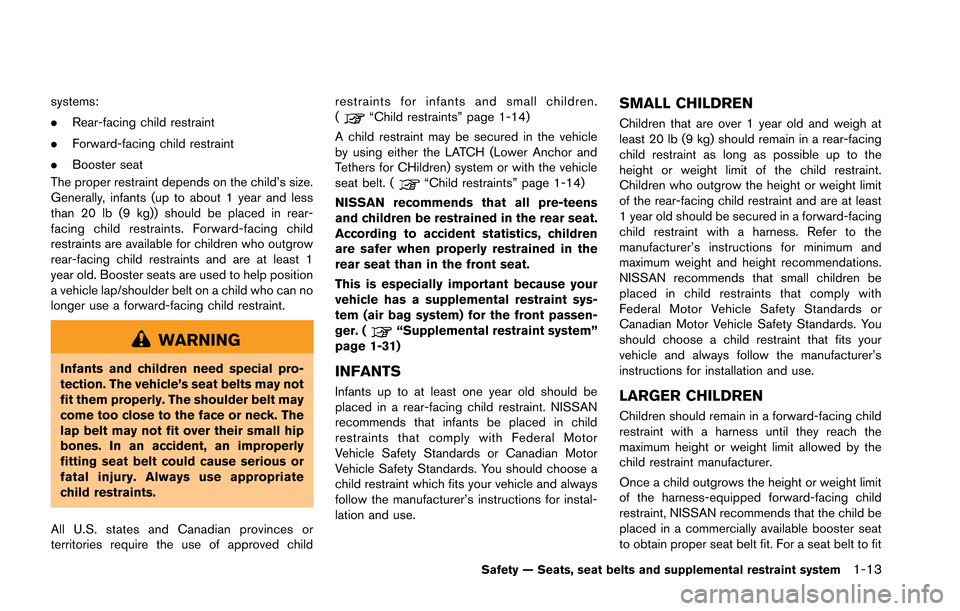
systems:
.Rear-facing child restraint
. Forward-facing child restraint
. Booster seat
The proper restraint depends on the child’s size.
Generally, infants (up to about 1 year and less
than 20 lb (9 kg)) should be placed in rear-
facing child restraints. Forward-facing child
restraints are available for children who outgrow
rear-facing child restraints and are at least 1
year old. Booster seats are used to help position
a vehicle lap/shoulder belt on a child who can no
longer use a forward-facing child restraint.
WARNING
Infants and children need special pro-
tection. The vehicle’s seat belts may not
fit them properly. The shoulder belt may
come too close to the face or neck. The
lap belt may not fit over their small hip
bones. In an accident, an improperly
fitting seat belt could cause serious or
fatal injury. Always use appropriate
child restraints.
All U.S. states and Canadian provinces or
territories require the use of approved child restraints for infants and small children.
(
“Child restraints” page 1-14)
A child restraint may be secured in the vehicle
by using either the LATCH (Lower Anchor and
Tethers for CHildren) system or with the vehicle
seat belt. (
“Child restraints” page 1-14)
NISSAN recommends that all pre-teens
and children be restrained in the rear seat.
According to accident statistics, children
are safer when properly restrained in the
rear seat than in the front seat.
This is especially important because your
vehicle has a supplemental restraint sys-
tem (air bag system) for the front passen-
ger. (
“Supplemental restraint system”
page 1-31)
INFANTS
Infants up to at least one year old should be
placed in a rear-facing child restraint. NISSAN
recommends that infants be placed in child
restraints that comply with Federal Motor
Vehicle Safety Standards or Canadian Motor
Vehicle Safety Standards. You should choose a
child restraint which fits your vehicle and always
follow the manufacturer’s instructions for instal-
lation and use.
SMALL CHILDREN
Children that are over 1 year old and weigh at
least 20 lb (9 kg) should remain in a rear-facing
child restraint as long as possible up to the
height or weight limit of the child restraint.
Children who outgrow the height or weight limit
of the rear-facing child restraint and are at least
1 year old should be secured in a forward-facing
child restraint with a harness. Refer to the
manufacturer’s instructions for minimum and
maximum weight and height recommendations.
NISSAN recommends that small children be
placed in child restraints that comply with
Federal Motor Vehicle Safety Standards or
Canadian Motor Vehicle Safety Standards. You
should choose a child restraint that fits your
vehicle and always follow the manufacturer’s
instructions for installation and use.
LARGER CHILDREN
Children should remain in a forward-facing child
restraint with a harness until they reach the
maximum height or weight limit allowed by the
child restraint manufacturer.
Once a child outgrows the height or weight limit
of the harness-equipped forward-facing child
restraint, NISSAN recommends that the child be
placed in a commercially available booster seat
to obtain proper seat belt fit. For a seat belt to fit
Safety — Seats, seat belts and supplemental restraint system1-13
Page 64 of 346
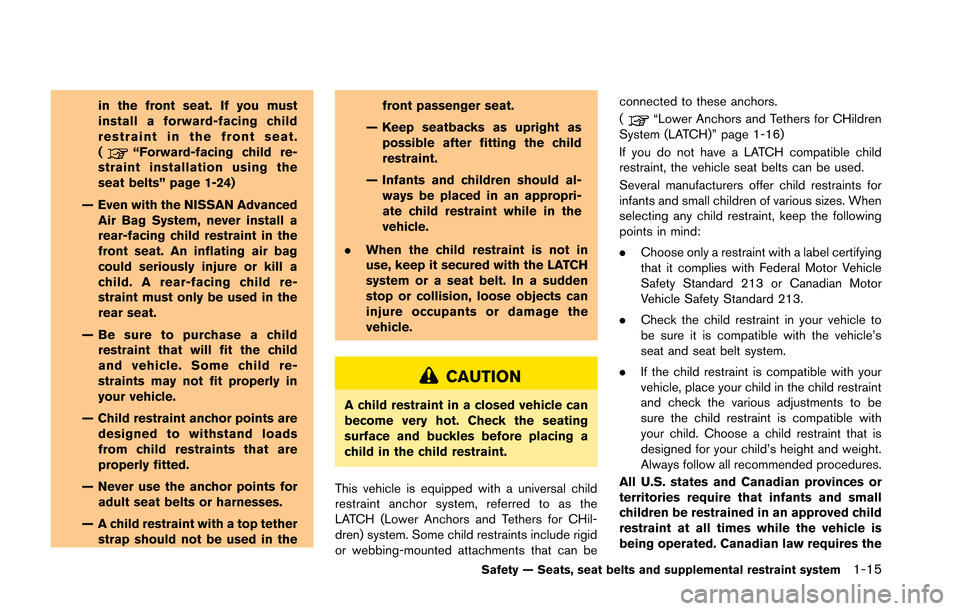
in the front seat. If you must
install a forward-facing child
restraint in the front seat.
(
“Forward-facing child re-
straint installation using the
seat belts” page 1-24)
— Even with the NISSAN Advanced Air Bag System, never install a
rear-facing child restraint in the
front seat. An inflating air bag
could seriously injure or kill a
child. A rear-facing child re-
straint must only be used in the
rear seat.
— Be sure to purchase a child restraint that will fit the child
and vehicle. Some child re-
straints may not fit properly in
your vehicle.
— Child restraint anchor points are designed to withstand loads
from child restraints that are
properly fitted.
— Never use the anchor points for adult seat belts or harnesses.
— A child restraint with a top tether strap should not be used in the front passenger seat.
— Keep seatbacks as upright as possible after fitting the child
restraint.
— Infants and children should al- ways be placed in an appropri-
ate child restraint while in the
vehicle.
. When the child restraint is not in
use, keep it secured with the LATCH
system or a seat belt. In a sudden
stop or collision, loose objects can
injure occupants or damage the
vehicle.
CAUTION
A child restraint in a closed vehicle can
become very hot. Check the seating
surface and buckles before placing a
child in the child restraint.
This vehicle is equipped with a universal child
restraint anchor system, referred to as the
LATCH (Lower Anchors and Tethers for CHil-
dren) system. Some child restraints include rigid
or webbing-mounted attachments that can be connected to these anchors.
(
“Lower Anchors and Tethers for CHildren
System (LATCH)” page 1-16)
If you do not have a LATCH compatible child
restraint, the vehicle seat belts can be used.
Several manufacturers offer child restraints for
infants and small children of various sizes. When
selecting any child restraint, keep the following
points in mind:
. Choose only a restraint with a label certifying
that it complies with Federal Motor Vehicle
Safety Standard 213 or Canadian Motor
Vehicle Safety Standard 213.
. Check the child restraint in your vehicle to
be sure it is compatible with the vehicle’s
seat and seat belt system.
. If the child restraint is compatible with your
vehicle, place your child in the child restraint
and check the various adjustments to be
sure the child restraint is compatible with
your child. Choose a child restraint that is
designed for your child’s height and weight.
Always follow all recommended procedures.
All U.S. states and Canadian provinces or
territories require that infants and small
children be restrained in an approved child
restraint at all times while the vehicle is
being operated. Canadian law requires the
Safety — Seats, seat belts and supplemental restraint system1-15
Page 299 of 346
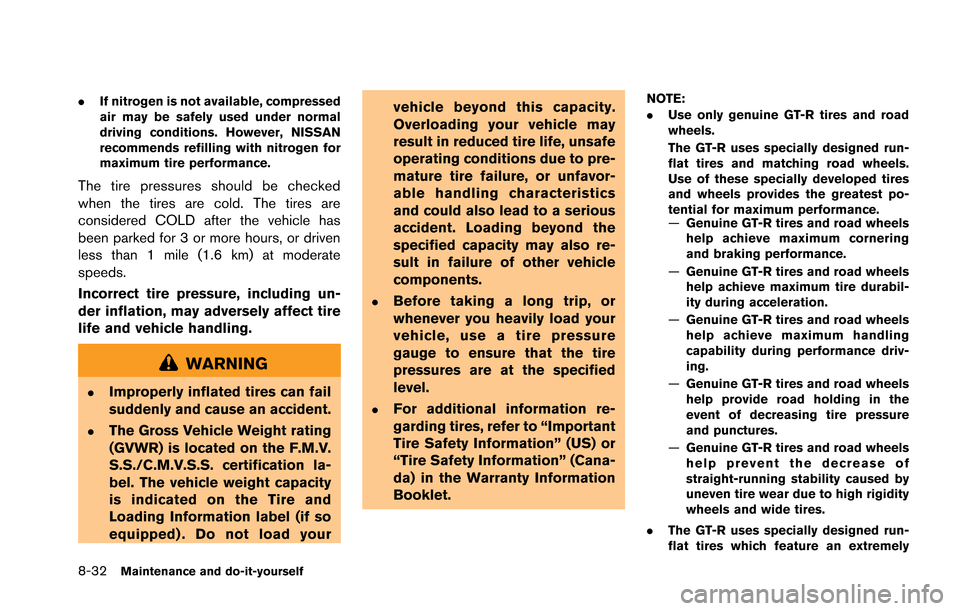
8-32Maintenance and do-it-yourself
.If nitrogen is not available, compressed
air may be safely used under normal
driving conditions. However, NISSAN
recommends refilling with nitrogen for
maximum tire performance.
The tire pressures should be checked
when the tires are cold. The tires are
considered COLD after the vehicle has
been parked for 3 or more hours, or driven
less than 1 mile (1.6 km) at moderate
speeds.
Incorrect tire pressure, including un-
der inflation, may adversely affect tire
life and vehicle handling.
WARNING
.Improperly inflated tires can fail
suddenly and cause an accident.
.The Gross Vehicle Weight rating
(GVWR) is located on the F.M.V.
S.S./C.M.V.S.S. certification la-
bel. The vehicle weight capacity
is indicated on the Tire and
Loading Information label (if so
equipped) . Do not load your vehicle beyond this capacity.
Overloading your vehicle may
result in reduced tire life, unsafe
operating conditions due to pre-
mature tire failure, or unfavor-
able handling characteristics
and could also lead to a serious
accident. Loading beyond the
specified capacity may also re-
sult in failure of other vehicle
components.
.Before taking a long trip, or
whenever you heavily load your
vehicle, use a tire pressure
gauge to ensure that the tire
pressures are at the specified
level.
.For additional information re-
garding tires, refer to “Important
Tire Safety Information” (US) or
“Tire Safety Information” (Cana-
da) in the Warranty Information
Booklet.
NOTE:
.
Use only genuine GT-R tires and road
wheels.
The GT-R uses specially designed run-
flat tires and matching road wheels.
Use of these specially developed tires
and wheels provides the greatest po-
tential for maximum performance.
—Genuine GT-R tires and road wheels
help achieve maximum cornering
and braking performance.
— Genuine GT-R tires and road wheels
help achieve maximum tire durabil-
ity during acceleration.
— Genuine GT-R tires and road wheels
help achieve maximum handling
capability during performance driv-
ing.
— Genuine GT-R tires and road wheels
help provide road holding in the
event of decreasing tire pressure
and punctures.
— Genuine GT-R tires and road wheels
help prevent the decrease of
straight-running stability caused by
uneven tire wear due to high rigidity
wheels and wide tires.
. The GT-R uses specially designed run-
flat tires which feature an extremely
Page 303 of 346
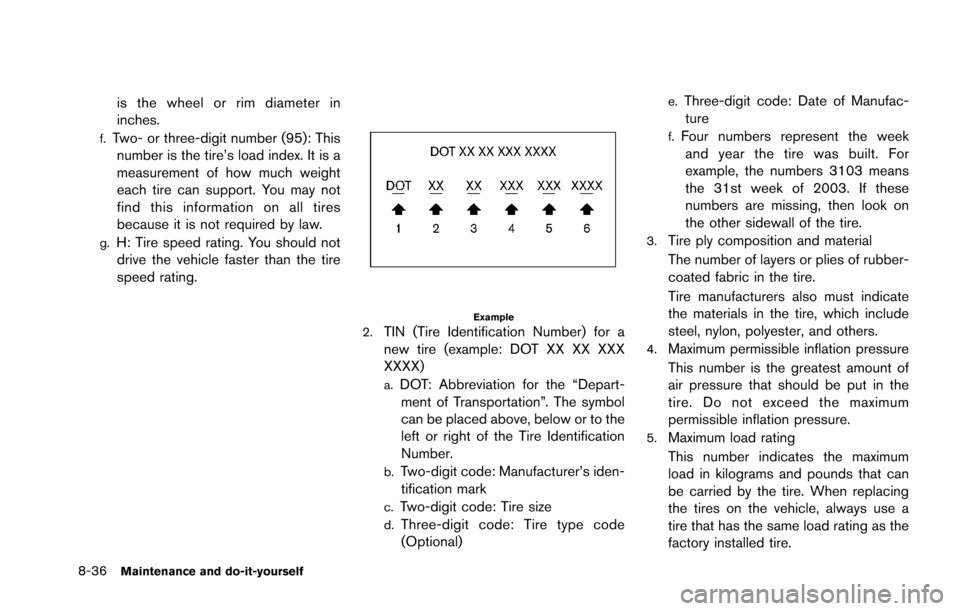
8-36Maintenance and do-it-yourself
is the wheel or rim diameter in
inches.
f.Two- or three-digit number (95): Thisnumber is the tire’s load index. It is a
measurement of how much weight
each tire can support. You may not
find this information on all tires
because it is not required by law.
g.H: Tire speed rating. You should notdrive the vehicle faster than the tire
speed rating.
Example
2.TIN (Tire Identification Number) for a
new tire (example: DOT XX XX XXX
XXXX)
a.DOT: Abbreviation for the “Depart- ment of Transportation”. The symbol
can be placed above, below or to the
left or right of the Tire Identification
Number.
b.Two-digit code: Manufacturer’s iden-tification mark
c.Two-digit code: Tire size
d.Three-digit code: Tire type code(Optional)
e.Three-digit code: Date of Manufac-
ture
f.Four numbers represent the week and year the tire was built. For
example, the numbers 3103 means
the 31st week of 2003. If these
numbers are missing, then look on
the other sidewall of the tire.
3.Tire ply composition and material
The number of layers or plies of rubber-
coated fabric in the tire.
Tire manufacturers also must indicate
the materials in the tire, which include
steel, nylon, polyester, and others.
4.Maximum permissible inflation pressure
This number is the greatest amount of
air pressure that should be put in the
tire. Do not exceed the maximum
permissible inflation pressure.
5.Maximum load rating
This number indicates the maximum
load in kilograms and pounds that can
be carried by the tire. When replacing
the tires on the vehicle, always use a
tire that has the same load rating as the
factory installed tire.
Page 314 of 346
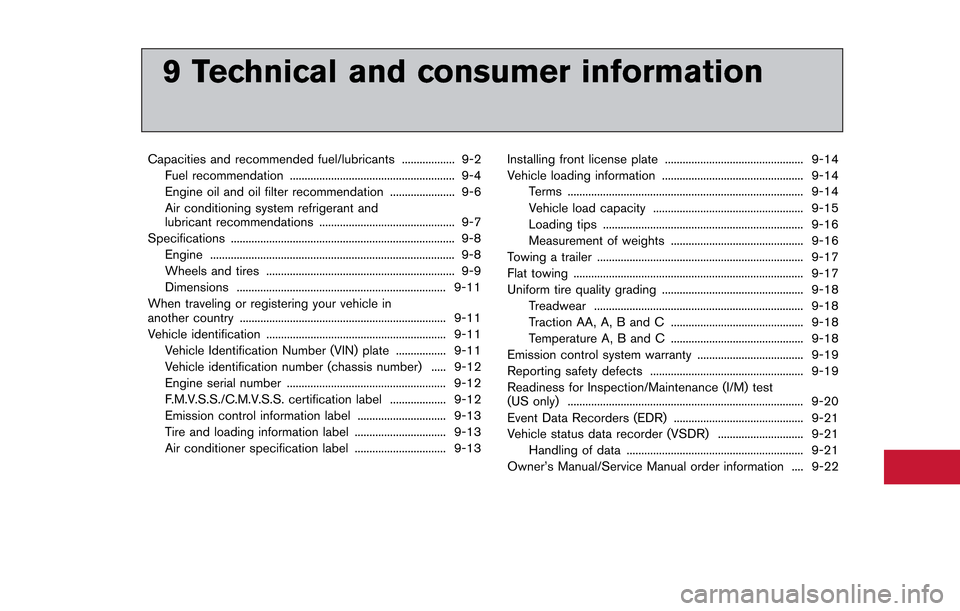
9 Technical and consumer information
Capacities and recommended fuel/lubricants .................. 9-2Fuel recommendation ........................................................ 9-4
Engine oil and oil filter recommendation ...................... 9-6
Air conditioning system refrigerant and
lubricant recommendations .............................................. 9-7
Specifications ........................................................................\
.... 9-8
Engine ........................................................................\
........... 9-8
Wheels and tires ................................................................ 9-9
Dimensions ....................................................................... 9-11
When traveling or registering your vehicle in
another country ...................................................................... 9-11 Vehicle identification ............................................................. 9-11 Vehicle Identification Number (VIN) plate ................. 9-11
Vehicle identification number (chassis number) ..... 9-12
Engine serial number ...................................................... 9-12
F.M.V.S.S./C.M.V.S.S. certification label ................... 9-12
Emission control information label .............................. 9-13
Tire and loading information label ............................... 9-13
Air conditioner specification label ............................... 9-13 Installing front license plate ............................................... 9-14
Vehicle loading information ................................................ 9-14
Terms ........................................................................\
........ 9-14
Vehicle load capacity ................................................... 9-15
Loading tips .................................................................... 9-16
Measurement of weights ............................................. 9-16
Towing a trailer ...................................................................... 9-17
Flat towing ........................................................................\
...... 9-17
Uniform tire quality grading ................................................ 9-18 Treadwear ....................................................................... 9-18
Traction AA, A, B and C ............................................. 9-18
Temperature A, B and C ............................................. 9-18
Emission control system warranty .................................... 9-19
Reporting safety defects .................................................... 9-19
Readiness for Inspection/Maintenance (I/M) test
(US only) ........................................................................\
........ 9-20
Event Data Recorders (EDR) ............................................ 9-21
Vehicle status data recorder (VSDR) ............................. 9-21 Handling of data ............................................................ 9-21
Owner’s Manual/Service Manual order information .... 9-22
Page 325 of 346
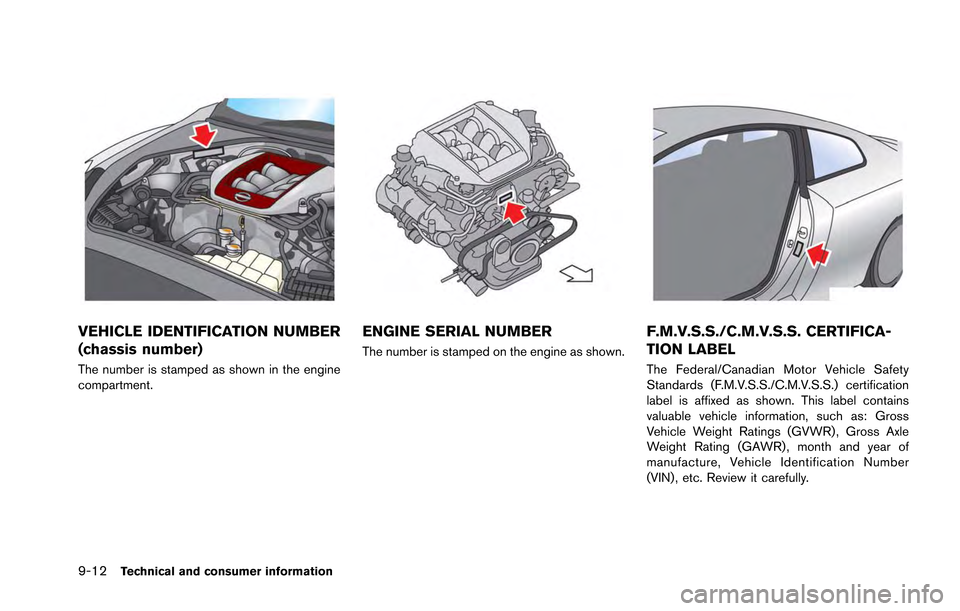
9-12Technical and consumer information
VEHICLE IDENTIFICATION NUMBER
(chassis number)
The number is stamped as shown in the engine
compartment.
ENGINE SERIAL NUMBER
The number is stamped on the engine as shown.
F.M.V.S.S./C.M.V.S.S. CERTIFICA-
TION LABEL
The Federal/Canadian Motor Vehicle Safety
Standards (F.M.V.S.S./C.M.V.S.S.) certification
label is affixed as shown. This label contains
valuable vehicle information, such as: Gross
Vehicle Weight Ratings (GVWR) , Gross Axle
Weight Rating (GAWR) , month and year of
manufacture, Vehicle Identification Number
(VIN) , etc. Review it carefully.
Page 327 of 346
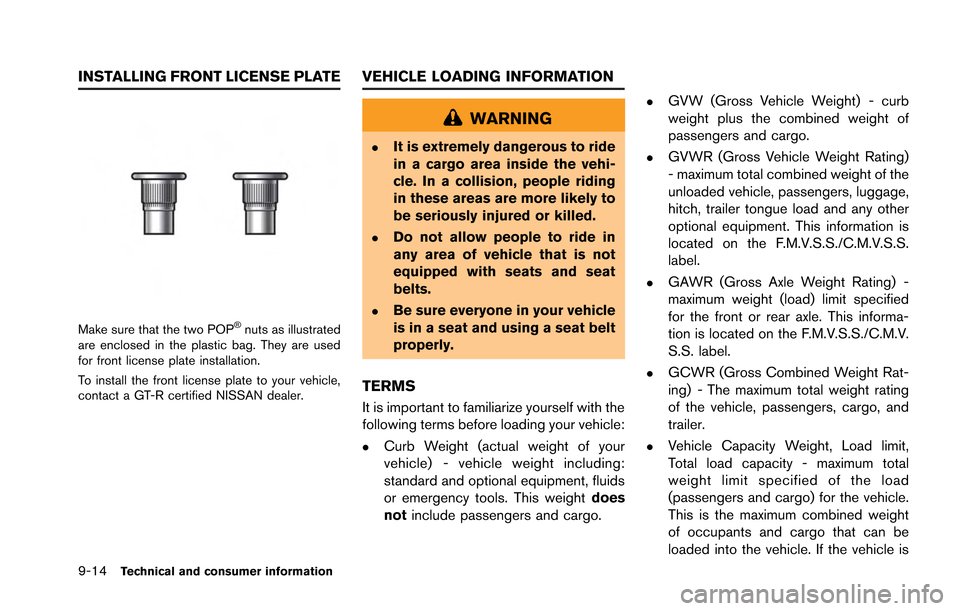
9-14Technical and consumer information
Make sure that the two POP®nuts as illustrated
are enclosed in the plastic bag. They are used
for front license plate installation.
To install the front license plate to your vehicle,
contact a GT-R certified NISSAN dealer.
WARNING
.It is extremely dangerous to ride
in a cargo area inside the vehi-
cle. In a collision, people riding
in these areas are more likely to
be seriously injured or killed.
.Do not allow people to ride in
any area of vehicle that is not
equipped with seats and seat
belts.
.Be sure everyone in your vehicle
is in a seat and using a seat belt
properly.
TERMS
It is important to familiarize yourself with the
following terms before loading your vehicle:
.Curb Weight (actual weight of your
vehicle) - vehicle weight including:
standard and optional equipment, fluids
or emergency tools. This weight does
not include passengers and cargo.
.GVW (Gross Vehicle Weight) - curb
weight plus the combined weight of
passengers and cargo.
.GVWR (Gross Vehicle Weight Rating)
- maximum total combined weight of the
unloaded vehicle, passengers, luggage,
hitch, trailer tongue load and any other
optional equipment. This information is
located on the F.M.V.S.S./C.M.V.S.S.
label.
.GAWR (Gross Axle Weight Rating) -
maximum weight (load) limit specified
for the front or rear axle. This informa-
tion is located on the F.M.V.S.S./C.M.V.
S.S. label.
.GCWR (Gross Combined Weight Rat-
ing) - The maximum total weight rating
of the vehicle, passengers, cargo, and
trailer.
.Vehicle Capacity Weight, Load limit,
Total load capacity - maximum total
weight limit specified of the load
(passengers and cargo) for the vehicle.
This is the maximum combined weight
of occupants and cargo that can be
loaded into the vehicle. If the vehicle is
INSTALLING FRONT LICENSE PLATE VEHICLE LOADING INFORMATION